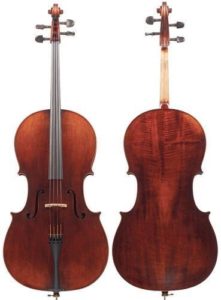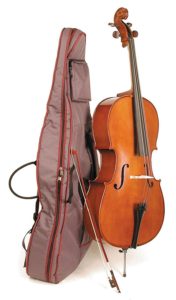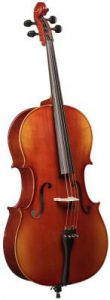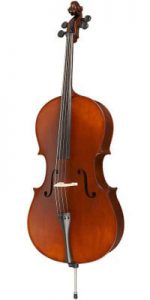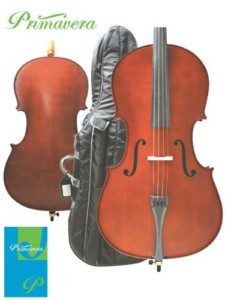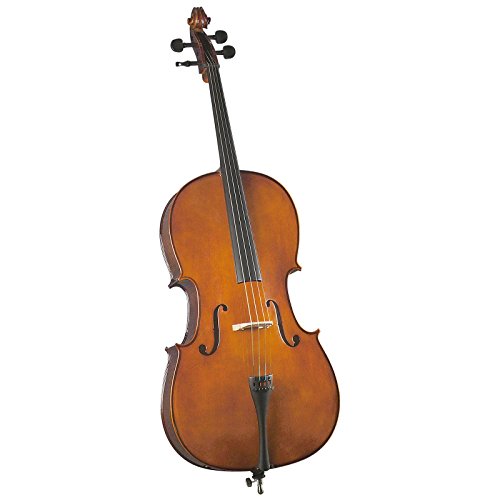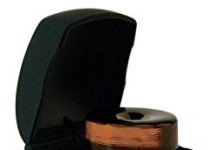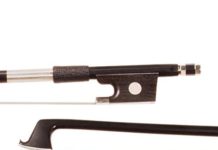Whether you are looking for a new cello for yourself, your child, or your student, it can be quite a process to find a new cello. Buying a cello can be expensive so you want to make sure that you are buying the right cello, especially if you’re looking to buy one online. That’s where we come in! We want you to buy a quality cello from a reputable online company. We have carefully screened all of the best cello brands below so that you know if you buy a cello from these companies, you know that you are getting a great one.






Best Cello Brand for Beginners
Cecilio, one of the most well-known cello brands, makes great instruments for beginners. Their cellos are high-quality at an affordable price. We recommend the CCO-100 and CCO-500 depending on your budget.
Features:
• Affordable
• Quality
• Complete starter kit
Best Cello Brand for Intermediate Players
Consistently rated as some of the best mid-tier cellos, D Z Strad cellos are known for their quality sound. Even though this is a mid-tier cello, the cellos come with everything you need to start playing.
Features:
• Highly rated
• High-quality sound
• Includes bow and case
Best Cello Brand for Advanced Players
Eastman’s hand-crafted cellos are known to be some of the best cellos for advanced players since they combine beauty with sound quality. Often going for $1,500+, these cellos should only be purchased by those who need a very high-quality instrument.
Features:
• Beautiful sound
• Look amazing
• Hand-crafted
Best Cello Brands
We have listed our favorite cello brands below. We’ll start with an overview of the best cellos for beginners, intermediate players, and advanced players. We’ll then list the remainder of our recommended cello brands below in the order that we recommend them. If you’re only looking for beginner cellos, check out our guide on the best cello brands for beginners.
Use this list as a guideline for which cello brands to buy. While not every cello brand on this list will fit your budget, experience level, or other search criteria, we hope it provides a great baseline to begin your search.
Cellos are expensive instruments, usually costing between $200-$5000 depending on the level of quality, so we wanted to make sure that we provided you with a list of the best cello brands.
Cecilio
Cecilio is a maker of great student cellos. They make student cellos are a large discount to traditional student cello manufacturers and their cellos are all hand-made. This is why we rated Cecilio as our number one cello brand.
Cecilio cellos are hand-carved from tonewoods with spruce tops, flamed maple sides and back, and inlaid purfling. This gives their cellos a look that exceeds their modest price point.
These cello outfits come with everything you need to get started, including a quality brazilwood bow with unbleached Mongolian horsehair and both a soft and hard case! Great value for your money.
[i2pc][i2pros]Includes everything a beginner needs to get started.
Very affordable.[/i2pros][i2cons]The strings aren’t of the highest quality. Upgrade to these.
Not great for intermediate or advanced students.[/i2cons][/i2pc]
Since Cecilio cellos provide so much value, we give them our highest recommendation as a beginner instrument. However, if you’re looking for an instrument for a more advanced player, we recommend that you look further.
Best Cellos for Beginners:
D Z Strad
DZ Strad cellos are our favorite mid-tier cello because of their sound quality and fine craftsmanship. The Model 150 in particular is a great instrument for the intermediate cello student because of these two features.
The company has workshops in New York and Minnesota so you know that these instruments are made with American quality in mind. The cellos themselves are hand-carved with Italian tonewoods that have been naturally dried which ensures stability.
[i2pc][i2pros]Great value for the price.
Included cello case and bow.
Great sound quality.[/i2pros][i2cons]We recommend upgrading the strings to Evah Pirazzi.[/i2cons][/i2pc]
D Z Strad cellos come with a soft cello case and a cello bow. For a high-quality cello that ranges between $600-$2000 depending on size, D Z Strad cellos offer a ton of value.
Recommended Models:
Eastman Strings
Recommended For: Advanced Cello Players
Eastman Strings is known for making high-quality intermediate and advanced cellos that sound beautiful. In fact, Strings Magazine often recommends the Eastman VC- 305 cello to players due to its superb playability and tone.
The cellos are handcrafted and come in either Stradivari or Tertis patterns. The cello package comes with a Despiau bridge and a metal alloy tailpiece.
If you buy Eastman cellos on Amazon, you’ll typically need to by the bow and cello case separatalely. As Eastman’s cellos designed for intermediate and advanced cellists, players typically know what type of cello bow they prefer.
Recommended Models:
D’Luca
Well-known for their accordions, D’Luca also makes great cellos and other musical instruments. The company is based in Ontario, California. They are a well-known supplier of cellos for school and orchestras, primarily focusing on the beginner and intermediate space.
The company inspires brand loyalty so many students who start on their student models progress to their intermediate models as well. The cellos are affordable and typically operate in the mid-range on pricing.
[i2pc][i2pros]Good, bright sound.
Complete outfits.[/i2pros][i2cons]Professional help may be needed to set up bridge and tailpiece.[/i2cons][/i2pc]
The cello outfits include everything a student needs to get started including stand, soft case, strings, tuner, bow, and rosin.
Recommended Models:
Stentor
Recommended For: Beginner Cello Players
Stentor cellos have made a name for themselves by making good quality cellos at an affordable price, similar to Cecilio. Stentors are great instruments to learn on before transferring to a professional cello. We like these beginner cellos and highly recommend them if you’re not into the Cecilios.
Stentor cellos are made in China, but inspected thoroughly in their United Kingdom workshops to make sure you are getting a quality instrument.
Stentor makes a wide variety of cellos that range from absolute beginner to intermediate. The cellos are made in various sizes and are quite sturdy, giving parents piece of mind about carrying the cellos to and from school.
Stentor cellos are crafted out of solid tonewoods and include a solid ebony fingerboard, pegs, and fittings with maple sides and back, and a spruce top.
The starter kits on Amazon come with a cello bag, bow (usually brazilwood), and rosin.
Recommended Models:
Knilling
Recommended For: Intermediate Cello Players
Knilling has been making cellos since 1922 and has developed a great reputation over the years. They’re well-known for having developed the Perfection Pegs which are far easier to turn than regular pegs, but look the same.
Their cellos have spruce tops and maple back and sides. While most of their cellos are made in China, they are inspected and assembled in Germany and the US before being sold.
Recommended Models:
Knilling Bucharest Model Carved Cello Outfit
Knilling Maestro Cello Outfit
Yamaha
Recommended For: Intermediate Cello Players
Yamaha is one of the most well-known musical instrument brands in the world. Widely known for their pianos and keyboards, they also make great stringed instruments. In particular, they make great electric cellos.
Recommended Models:
Primavera Cellos
Recommended For: Intermediate Cello Players
Primavera cellos are a very affordable intermediate cello brand. Slightly more expensive than many of the beginner brands ($600-$1000), Primavera cellos are made out of high quality solid tonewoods, including hand carved maple and spruce with inlaid purfling. The fingerboard and pegs are made out of carved ebony, as well as the fittings. In addition, the Primavera intermediate cello outfit comes with a “student-proof” (ie. very strong) composite bow with an ebony frog and Mongolian horsehair. To make it even more student-proof, you can get a hard cello case for it.
Primavera has made several decisions to cut costs while improving the musical experience. For example, they use a metal alloy tailpiece with four fine tuners, instead of a solid wood tailpiece.
Primavera beginner cello outfits come in many sizes, so you can find the proper fit for you or your child. Most also come with a hardwood bow and soft bag.
Cremona
Recommended For: Beginner Cello Players
Cremona cellos make great beginner instruments for a decent price tag. While the parts are made in China, Cremona cellos are assembled in California, so there is definitely American craftsmanship involved. Made out of select tone woods, such as hand-carved maple, spruce, and ebony, these cellos perform pretty well as-is, but can sound a lot better with minor improvements.
Out-of-the-box, Cremona cellos come with Prelude strings which are okay, but swapping them out for a higher-quality cello string brand can make a world of difference.
Cremona cellos are manufactured in the Cremona workshop in California using MENC standards. The MENC standard ensures that the instruments are playable out-of-the-box, and can be easily integrated into your child’s school orchestra or ensemble.
Each outfit on Amazon is shipped with a high-quality Brazilwood bow and a cello bag.
Best Cremona Cellos:
Merano
Recommended For: Beginner
Merano’s make great beginner cellos for those who are very price-concious. Most of their cellos sell for a little more than $200, and while you won’t be able to sell them for much, they will meet the requirements of any beginner who needs a basic instrument to get started.
Merano fingerboards are not made from ebony so you will probably need to replace the fingerboard at some point if you keep it for long enough.
If you are on a budget, Merano cellos will work well.
Outfits on Amazon include a ton of extras including an extra set of strings, an extra bridge, rosin, cello bag, music stand, and electronic tuner. Buying a Merano cello outfit is one way to be up and playing in no time.
Recommended Models:
Table of Contents
What Cello Size Do You Need?
Like violins and violas, cellos can be found in a variety of shapes and sizes, and choosing the one that suits your needs best is not always easy. In fact, your age, shape, and height can affect your final decision. Below we’ve outlined a few ways to find the cello size you need. So, what size cello do you need?
About cello sizes
Cellos come in a variety of sizes, but the most common ones are the following: 4/4, known as full size, 3/4, 1/2 and 1/4.
Generally speaking, an adult will play the full-size cello, but there is also, the option of a 7/8 size for those having some hard time playing the 4/4 one. Although the sizes mentioned above apply as a general rule, you cannot be really sure that a 4/4 sized cello is ideal for your physical structure.
Therefore, you need to make a more accurate measurement in order to rest assured that you pick the right cello size.
How to measure using a cello?
If you can actually try cellos of different sizes in-person, then you can determine the cello size that seems to fit. To start, sit on a chair with your knees bent at 90 degrees angle. Hold the cello firmly and check if:
- the neck of your cello lies a few inched away from your left shoulder
- the upper edge of it rests securely on your sternum
- the lower corner barely touches your left knee
- the thickest string of the cello is close to your left ear.
If all of the above conditions are met, then the cello is probably the best for you.
What if I don’t have a variety of cellos available?
If you cannot try on different sizes of cellos, you can have an approximate idea about the one that suits you best by performing three different measurements.
Firstly, you need to know your height. For adults measuring 5 feet and more, a typical full-sized cello is usually the ideal option. If you measure between 4.6-5 feet, then you should probably opt for a 3/4 cello.
Another measurement includes the length of your arm. In order to measure that successfully, you need to measure the distance between the tip of your middle finger and your shoulder pocket. If the number is something like 24 cm or more, then the 4/4 cello size is good. On the other hand, if the measurement shows a number between 22 to 24 inches, then you should probably go with a 3/4 sized cello.
Finally, a good way to measure is to use the distance between the tip of your index finger and the tip of the pinky. A distance between 5-6 cm is a sign that you need a 3/4 cello, while a measurement of 6 cm and more showcases that you need a full-size cello.
Choosing the ideal cello size is vital in order to be able to exercise your performance with ease and not get fatigued. With so many available choices on the market nowadays, you may feel overwhelmed when the time comes for you to choose the ideal size.
However, if you take some important factors into account, including your physical structure and age, then you can narrow down your available choices. Ideally, if you can try on some different cellos, you will be able to find the one that suits your needs best!
How to Buy a Cello
When it comes to buying a cello, it is never a one-size-fits-all matter. Unlike the violin and viola, the cello is much larger so the individual’s size must be taken into account. Even among cellos of the same size, there might be differences in their sound due to their different details like strings, wood materials and so on. Amateur and professional cellists have all encountered problems when getting the perfect fit – size, acoustics, projection and comfort. So how do you go about buying a cello? What should you consider when buying a cello? What cello brand is right for you?
Before you even consider buying a cello, you should make you understand how to find the best cello and what you should look for in a cello. Read our guide on how to buy a cello to understand what makes a great cello and how to find one that fits in your budget.
You can also read our article about how to get started playing the cello to learn more about what to expect once you’ve bought a cello.
Should I Even Buy a Cello?
The first question you need to ask when looking to buy a cello is whether buying is even the right option for you. This guide should help you make the decision between buying versus renting your cello.
The other question you should ask yourself is whether the cello is even the right instrument for you. This is a critical question since the cello is an expensive purchase.
Once you have answers to both of these questions, you can continue reading below.
Different Levels
Cellos come in different levels for players on different stages of their learning journey. Many students start out by renting cellos for practice until they are ready to own one. Essentially, cellos fall under three categories:
- Student Cellos: These are for beginners. Young students or players at the early stage of learning the cello are constantly working on the basics of playing, tone production, fingering, bowing etc. Hence, maple (dyed black to resemble ebony) is sometimes used for the pegs and fingerboards, areas that are exposed to more friction. Student cellos are mostly machine-made to keep costs low while maintaining tone consistency. Quite affordable. Prices range from $200 – $2,500.
- Intermediate to Advanced Cellos: With higher workmanship, the sound of an intermediate cello is also much better. There are more dynamics and stronger projection. The pegs and fingerboards are crafted with ebony and most of the instrument is handcrafted. Prices range from $500 – $10,000.
- Professional Cellos: Pure craftsmanship using the finest quality of wood, professional cellos exude a rich tone and wide dynamics. Masterpieces like these are expensive. Prices go from $10,000 onwards.
Typically, how much one pays for a cello is how much one can expect from the quality. A cello priced at the extreme low hundreds tends to be “unplayable” while the more expensive ones can balance both playability and sound production better. Of course, the price is not always merely an indication of product quality. Sometimes, it also incorporates the name of the cello maker. As a cello maker’s fame increases, so does the value of the instruments he crafts.
How to Choose the Right Cello
Ask Your Teacher
The first piece of advice given by experts, cello makers and professional cellists would be for the student to consult his or her teacher. Music teachers understand what their students need more than anyone would. They can make better recommendations given their experience and close bond with the students.
Test Cellos
The second piece of advice would be to go to a violin shop and test out their cellos. Cellos are less well-known than violins. Naturally, there will not be a variety of cellos as comprehensive as the violins to choose from. Give our best cellos brands guide a review before you go to test cellos so that you know which cello brands to look for. The selection may be scarce at general music shops but that selection will open up a lot more at a good violin shop. Try not to purchase a cello over the Internet without testing it first. Trying out an instrument in person is crucial. Only then can the student feel if the size is comfortable, the projection far enough, or if the resonance is right.
Here are other factors for consideration:
- The size affects the sound. Cellos come in a variety of sizes ranging from 1/16 up to 4/4 (full-size). While most students early on will play on instruments somewhere between 1/8-1/2, most adults play 3/4 or 4/4 depending on their size. The bigger the cello, the more tone is produced by the instrument, making the cellist sound more mature.
- The height of the ribs, the size of the upper bout, neck size, string or scale length all contribute to how big the instrument feels and how well it plays. Comfort matters more than size in the sense that if a cellist struggles during the playing experience, she simply won’t play well.
- Responsiveness, resonance, tone, projection. The cello’s sound is mellow and darker in nature. In an orchestra, the cellist needs to make sure that she can be heard above the other instruments, hence projection in particular is very important. All of these sound elements will affect a player’s performance, which is why choosing a cello in person rather than over the Internet, or investing in a higher quality cello, is necessary.
- Getting a powerful C string is sweet, but do not neglect the other strings. Ensure there is coherence in sound quality in all four strings. Also, it seems that shorter strings are more comfortable to play on, but longer strings may give a slightly stronger power. It all depends on what it is the player prizes.
- The quality and weight of the bow can affect a performance. Be sure to test several of them out before buying.
To evaluate the cellos, test them with different bows, play scales, play different passages (both fast and slow ones), play all strings in all registers, and play with and without vibrato. Check the tone of different cellos. Which sounds most appealing? Is it easy to move on the fingerboard? If possible, ask someone else (perhaps another cellist or teacher in the shop) to play the cello while you stand across the room to listen. Does the sound project well?
Quality of the Material
The quality of the cello material impacts both the sound and the viola price. Cheaper woods from America and China usually have a brighter sound compared with the warmer and sweeter tones of the more-expensive European woods. The “flame,” or as some say “tiger stripe,” on the back, sides and scroll of the cello affects the cello price than the top spruce grain. A high “flame” content is highly desired for its beauty and is generally indicative of a higher cello price and better the sound as compared to a cello with little or no “flame,” mostly found on student instrument’s. A well-made cello will be able to hide the center crease on the back with the flame. This is one way of quickly identifying quality workmanship.
Where to Buy a Cello
It is not necessary to buy extremely expensive cellos. There are plenty of high quality instruments in the mid-price range that could also be satisfying. The main thing to remember is to purchase from a reputable retailer that has a refund policy and which allows you to try out their instruments. Consult a teacher for recommendations if possible. Other retailers are second-hand retailers, luthiers and, if the Internet is your only choice, Amazon and eBay.
Should You Rent or Buy a Cello?
If you are shopping for a student cello, you will often be tempted to rent an instrument so that there is no long-term commitment and you don’t have to worry about reselling if the student doesn’t continue playing past the contract period. However, there are several good reasons why buying a cello instead of renting is a good idea:
- Rental fees often add up quickly. Let’s say you have a 12-month rental contract where you pay $30/month. In the end you’ll end up paying $360, when you could’ve bought a new or gently used cello for ~$200. While many music shops will give you rental credit during the contract that could be used to buy a cello at the end of the contract, you’d probably be better off buying the cello outright.
- Music shops will often all you trade up cellos you have bought from them or other shops. If you need a bigger or better cello, most music shops will defray the new cello price with the resale value of the cello you bought originally.
- A well-chosen beginner’s instrument that is well cared for will retain its value and usually return a substantial part of its purchase price when sold used or traded in for a better quality instrument.
- Higher-quality cellos may appreciate in value over time; their voices “open up” as they age.
- Rental instruments may be a bit worse for wear with nicks, scratches, tape marks on the fingerboard, and come with used strings and an already rosined bow. You’re also liable for any damage on a rented cello.
What Else Do You Need?
For a complete list of cello accessories, you will need to buy in addition to the cello, see our Buying a Cello guide.
- Case: To store your cello, you need a solid case since the instrument is very fragile. If the cello is for a student, a sturdy case is even more of a necessity. Most beginner cello outfits come with a soft case, but just in case (no pun intended), there are some great hard cello cases on Amazon.
- Rosin: Rosin is applied to your bow and used to create friction between your bow and cello. Without rosin, your cello would not make any sound.
- Bow: Picking the right cello bow to use with your cello is key. You need to make sure it sounds good, but at a reasonable price. See our guide to buying a cello bow.
- Rock Stop: The rock stop is optional, but allows you to keep the cello from slipping.
- Extra Strings: While not as likely to break or fray as violin strings, cello strings do occasionally break. Keeping an extra pair in your case is highly recommended. You can check out our review of the best cello strings to see which ones are best for you.
Protecting Your Investment
Once you’ve decided on a cello to buy you’ll want to make sure it is protected from loss, damage, and theft. Replacing such an expensive instrument can cost you a lot of money. In order to protect your investment, you should get musical instrument insurance. You can read our guide on buying musical instrument insurance for your cello to learn more.
Cello Brands to Avoid
There are a lot of cello brands on the market so it’s important to find a reputable one. All of the cello brands on this list are reputable.
If you find a cello brand that is not on this list and you’re trying to know whether you should avoid it, our recommendation is to check out the seller reputation. Amazon offers competitive prices for example, but some of the third-party sellers are unknown. We recommend checking out their reviews and research the sellers first.
While Chinese-made cellos sometimes get a bad reputation, many cellists have reported some Chinese cellos that are better quality than Germany and US-made cellos.
Conclusion
While most of the best cello brand outfits above come with everything you need to get started, some of the packages don’t come with everything you need. Cellos need the following basic accessories such as rosin, a rock stop, a bow, a case/bag, etc. To find out what else you need, check out this buying checklist for cellos.
Buying a cello online is a fairly recent thing with the advent of the internet. If you don’t feel comfortable buying an instrument online, we recommend trying out cellos at a local music shop before you shop online for the best deal. However, if you feel comfortable with Amazon’s return policy, you can certainly buy from them and return the cello if it doesn’t sound quite right.



